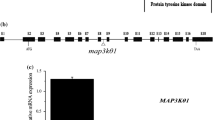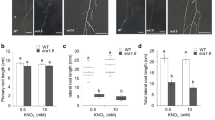Abstract
Main conclusion
CRK28, a cysteine-rich receptor-like kinase, plays a role in root organogenesis and overall growth of plants and antagonizes abscisic acid response in seed germination and primary root growth.
Abstract
Receptor-like kinases (RLK) orchestrate development and adaptation to environmental changes in plants. One of the largest RLK groups comprises cysteine-rich receptor-like kinases (CRKs), for which the function of most members remains unknown. In this report, we show that the loss of function of CRK28 led to the formation of roots that are longer and more branched than the parental (Col-0) plantlets, and this correlates with an enhanced domain of the mitotic reporter CycB1:uidA in primary root meristems, whereas CRK28 overexpressing lines had the opposite phenotype, including slow root growth and reduced lateral root formation. Epidermal cell analyses revealed that crk28 mutants had reduced root hair length and increased trichome number, whereas 35S::CRK28 lines present primary roots with longer root hairs but lesser trichomes in leaves. The overall growth in soil of crk28 mutant and CRK28 overexpressing lines was reduced or enhanced, respectively, when compared to the parental (Col-0) seedlings, while germination, root growth and expression analyses of ABI3 and ABI5 further showed that CRK28 modulates ABA responses, which may be important to fine-tune plant morphogenesis. Our study unravels the participation of RLK signaling in root growth and epidermal cell differentiation.








Similar content being viewed by others
References
Blilou I, Frugier F, Folmer S, Serralbo O, Willemsen V, Wolkenfelt H, Eloy NB, Ferreira PC, Weisbeek P, Scheres B (2002) The Arabidopsis HOBBIT gene encodes a CDC27 homolog that links the plant cell cycle to progression of cell differentiation. Genes Dev 16(19):2566–2575
Boerjan W, Cervera MT, Delarue M, Beeckman T, Dewitte W, Bellini C, Caboche M, Van Onckelen H, Van Montagu M, Inzé D (1995) Superroot, a recessive mutation in Arabidopsis, confers auxin overproduction. Plant Cell 7:1405–1419
Bourdais G, Burdiak P, Gauthier A, Nitsch L, Salojärvi J, Rayapuram C et al (2015) Large-scale phenomics identifies primary and fine-tuning roles for CRKs in responses related to oxidative stress. PLoS Genet 11:e1005373. https://doi.org/10.1371/journal.pgen.1005373
Braun DM, Walker JC (1996) Plant transmembrane receptors: new pieces in the signaling puzzle. Trends Biochem Sci 21(2):70–73
Burdiak P, Rusaczonek A, Witoń D, Głów D, Karpiński S (2015) Cysteine-rich receptor-like kinase CRK5 as a regulator of growth, development, and ultraviolet radiation responses in Arabidopsis thaliana. J Exp Bot 66(11):3325–3337
Chen K, Fan B, Du L, Chen Z (2004) Activation of hypersensitive cell death by pathogen-induced receptor-like protein kinases from Arabidopsis. Plant Mol Biol 56:271–283
Colón-Carmona A, You R, Haimovitch-Gal T, Doerner P (1999) Spatio-temporal analysis of mitotic activity with a labile cyclin–GUS fusion protein. Plant J 20(4):503–508
Curtis MD, Grossniklaus U (2003) A gateway cloning vector set for high-throughput functional analysis of genes in planta. Plant Physiol 133(2):462–469
Dubrovsky JG, Sauer M, Napsucialy-Mendivil S, Ivanchenko MG, Friml J, Shishkova S, Celenza J, Benková E (2008) Auxin acts as a local morphogenetic trigger to specify lateral root founder cells. Proc Natl Acad Sci USA 105:8790–8794
Finch-Savage WE, Leubner-Metzger G (2006) Seed dormancy and the control of germination. New Phytol 171:501–523
Finkelstein RR, Gampala SS, Rock CD (2002) Abscisic acid signaling in seeds and seedlings. Plant Cell 14:S15–S45
Grierson C, Schiefelbein J (2002) Root hairs. Arabidopsis Book 1:e0060
Hématy K, Höfte H (2008) Novel receptor kinases involved in growth regulation. Curr Opin Plant Biol 11:321–328
Hobbie L, Estelle M (1994) Genetic approaches to auxin action. Plant Cell Environ 17:525–540
Idänheimo N, Gauthier A, Salojärvi J, Siligato R, Brosché M, Kollist H, Mähönen AP, Kangasjärvi J, Wrzaczek M (2014) The Arabidopsis thaliana cysteine-rich receptor-like kinases CRK6 and CRK7 protect against apoplastic oxidative stress. Biochem Biophys Res Commun 445:457–462
Ishida T, Kurata T, Okada K, Wada T (2008) A genetic regulatory network in the development of trichomes and root hairs. Ann Rev Plant Biol 59:365–386
Kumar D, Kumar R, Baek D, Hyun TK, Chung WS, Yun DJ, Kim JY (2017) Arabidopsis thaliana RECEPTOR DEAD KINASE1 functions as a positive regulator in plant responses to ABA. Mol Plant 10:223–243
Larkin JC, Young N, Prigge M, Marks MD (1996) The control of trichome spacing and number in Arabidopsis. Development 122:997–1005
Leung J, Giraudat J (1998) Abscisic acid signal transduction. Annu Rev Plant Physiol Plant Mol Biol 49:199–222
Livak KJ, Schmittgen TD (2001) Analysis of relative gene expression data using real-time quantitative PCR and the 2−ΔΔCT method. Methods 25(4):402–408
Lopez-Molina L, Mongrand S, Chua NH (2001) A postgermination developmental arrest checkpoint is mediated by abscisic acid and requires the ABI5 transcription factor in Arabidopsis. Proc Natl Acad Sci USA 98:4782–4787
Lu K, Liang S, Wu Z, Bi C, Yu YT, Wang XF, Zhang DP (2016) Overexpression of an Arabidopsis cysteine-rich receptor-like protein kinase, CRK5, enhances abscisic acid sensitivity and confers drought tolerance. J Exp Bot 67(17):5009–5027
Malamy JE, Benfey PM (1997) Organization and cell differentiation in lateral roots of Arabidopsis thaliana. Development 124:33–44
Morris ER, Walker JC (2003) Receptor-like protein kinases: the keys to response. Curr Opin Plant Biol 6:339–342
Nemhauser JL, Hong F, Chory J (2006) Different plant hormones regulate similar processes through largely nonoverlapping transcriptional responses. Cell 126:467–475
Nibau C, Cheung AY (2011) New insights into the functional roles of CrRLKs in the control of plant cell growth and development. Plant Signal Behav 6(5):655–659
Ohtake Y, Takahashi T, Komeda Y (2000) Salicylic acid induces the expression of a number of receptor-like kinase genes in Arabidopsis thaliana. Plant Cell Physiol 41(9):1038–1044
Runyon JB, Mescher MC, De Moraes CM (2010) Plant defenses against parasitic plants show similarities to those induced by herbivores and pathogens. Plant Signal Behav 5(8):929–931
Serna L (2004) A network of interacting factors triggering different cell fates. Plant Cell 16:2258–2263
Shiu SH, Bleecker AB (2001) Plant receptor-like kinase gene family: diversity, function, and signaling. Sci STKE Signal Trans Knowl Env 113:re22
Tanaka H, Osakabe Y, Katsura S, Mizuno S, Maruyama K, Kusakabe K, Mizoi J, Shinozaki K, Yamaguchi-Shinozaki K (2012) Abiotic stress-inducible receptor-like kinases negatively control ABA signaling in Arabidopsis. Plant J 70:599–613
Tiryaki I, Staswick P (2002) An Arabidopsis mutant defective in jasmonate response is allelic to the auxin-signaling mutant axr1. Plant Physiol 130:887–894
Torii KU (2004) Leucine-rich repeat receptor kinases in plants: structure, function, and signal transduction pathways. Int Rev Cytol 234:1–46
Van Poecke RMP (2007) Arabidopsis-insect interactions. Arabidopsis Book 5:e0107
Verslues PE, Zhu JK (2005) Before and beyond ABA: upstream sensing and internal signals that determine ABA accumulation and response under abiotic stress. Biochem Soc Trans 33:375–379
Wagner GJ, Wang E, Shepherd RW (2004) New approaches for studying and exploiting an old protuberance, the plant trichome. Ann Bot 93:3–11
Walker JC (1994) Structure and function of the receptor-like protein kinases of higher plants. Plant Mol Biol 26:1599–1609
Wasilewska A, Vlad F, Sirichandra C, Redko Y, Jammes F, Valon C, Freidit Frey N, Leung J (2008) An update on abscisic acid signaling in plants and more. Mol Plant 1:198–217
Werker E (2000) Trichome diversity and development. In: Hallahan DL, Gray JC (eds) Plant trichomes, vol 31. Academic Press, San Diego, pp 1–35
Wilson AK, Pickett FB, Turner JC, Estelle M (1990) A dominant mutation in Arabidopsis confers resistance to auxin, ethylene and abscisic acid. Mol Gen Genet 222:377–383
Wrzaczek M, Brosché M, Salojärvi J, Kangasjärvi S, Idänheimo N, Mersmann S, Robatzek S, Karpiński S, Karpińska B, Kangasjärvi J (2010) Transcriptional regulation of the CRK/DUF26 group of receptor-like protein kinases by ozone and plant hormones in Arabidopsis. BMC Plant Biol 10:95
Xin Z, Zhao Y, Zheng ZL (2005) Transcriptome analysis reveals specific modulation of abscisic acid signaling by ROP10 small GTPase in Arabidopsis. Plant Physiol 139:1350–1365
Yadeta KA, Elmore JM, Creer AY, Feng B, Franco JY, Rufian JS, He P, Phinney B, Coaker G (2017) A cysteine-rich protein kinase associates with a membrane immune complex and the cysteine residues are required for cell death. Plant Physiol 173:771–787
Zhang X, Henriques R, Lin SS, Niu QW, Chua NH (2006) Agrobacterium-mediated transformation of Arabidopsis thaliana using the floral dip method. Nat Protocols 1(2):641–646
Zhang X, Yang G, Shi R, Han X, Qi L, Wang R, Xiong L, Li G (2013) Arabidopsis cysteine-rich receptor-like kinase 45 functions in the responses to abscisic acid and abiotic stresses. Plant Physiol Biochem 67:189–198
Acknowledgements
This work was supported by the Consejo Nacional de Ciencia y Tecnología Grant 177775, the Consejo de la Investigación Científica UMSNH Grant 2.26, and a Marcos Moshinsky fellowship to JLB.
Author information
Authors and Affiliations
Corresponding author
Additional information
Publisher's Note
Springer Nature remains neutral with regard to jurisdictional claims in published maps and institutional affiliations.
Electronic supplementary material
Below is the link to the electronic supplementary material.
425_2019_3296_MOESM1_ESM.tif
Supplementary figure 1. Expression of CRK28 gene in crk28 mutant and 35S::CRK28 overexpression lines. (a) Schematic representation of T-DNA insertion site (black triangle) at first exon in the Salk_085178 mutant line. Exons are shown in blue rectangles, and introns in solid lines. RT-PCR analysis of CRK28 gene in control and crk28 mutant plants; UBQ5 gene was used as loading control. (b) Schematic representation of the 35S::CRK28 construct in pMDC32 binary vector. RB, right border for T-DNA integration; 2 × 35S, cauliflower mosaic virus 35S promoter; attB1 and attB2 sites for recombination; A. thaliana CRK28 gDNA; nos T, nopaline synthase terminator region; HPTII, hygromycin resistance gene; LB, left border for T-DNA integration. qRT-PCR expression levels of CRK28 in the Arabidopsis overexpression lines is represented as normalized fold change, and was calculated comparing the target gene expression with a control (Col-0), after normalization to the Arabidopsis UBQ5 gene using the (2−ΔΔCt) method. Bars represent mean ± SE (n = 3) of two experimental replicates (TIFF 200 kb)
425_2019_3296_MOESM2_ESM.tif
Supplementary figure 2. Expression of CycB1:uidA in lateral root primordia of WT, crk28 and 35S:CRK28 seedlings. Seedlings were grown for 7 days on MS0.2x solidified medium under standard growth conditions, and then stained for GUS expression. Representative photographs show the expression of CycB1:uidA at different stages of development of LRP. Representative pictures were selected from at least 10 seedlings analyzed (Scale bar = 50 μm) (TIFF 6161 kb)
425_2019_3296_MOESM3_ESM.tif
Supplementary figure 3. Effect of low concentrations of abscisic acid on primary root length of wild-type (Col-0), crk28 and 35S:CRK28 seedlings. Arabidopsis WT, crk28 and 35S:CRK28 seedlings were germinated and grown for 3 days on MS 0.2x medium and then transferred to fresh medium with or without 1 or 2 µM ABA. Seven-days after transfer, primary root length was analyzed. Bars represent the means and SE from 10 seedlings. Different letters indicate statistical differences at P<0.05. The experiment was repeated three times with similar results (TIFF 358 kb)
Rights and permissions
About this article
Cite this article
Pelagio-Flores, R., Muñoz-Parra, E., Barrera-Ortiz, S. et al. The cysteine-rich receptor-like protein kinase CRK28 modulates Arabidopsis growth and development and influences abscisic acid responses. Planta 251, 2 (2020). https://doi.org/10.1007/s00425-019-03296-y
Received:
Accepted:
Published:
DOI: https://doi.org/10.1007/s00425-019-03296-y




